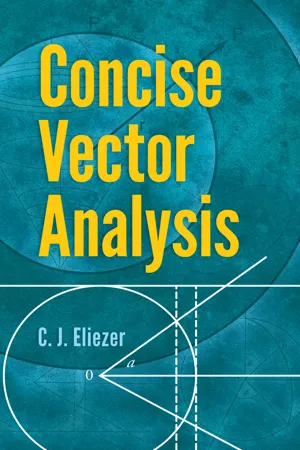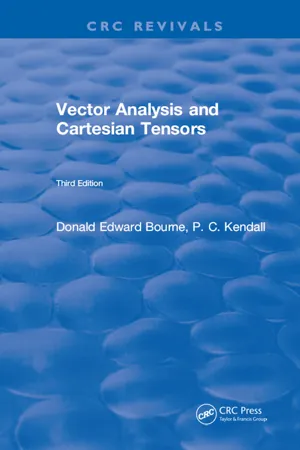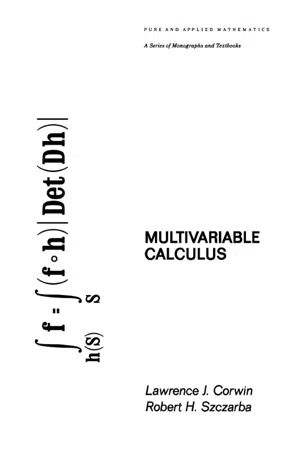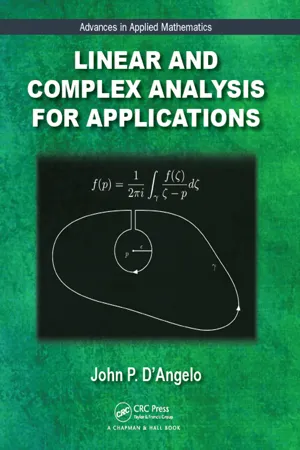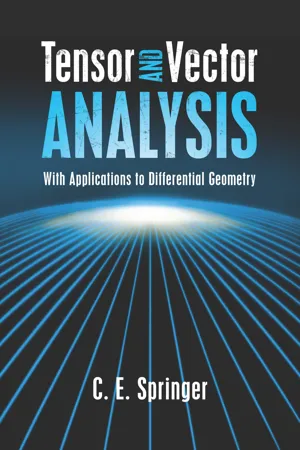Physics
Surface Integral
A surface integral is a mathematical tool used to calculate the flux of a vector field across a surface. It involves integrating the dot product of the vector field and the surface normal over the surface. Surface integrals are commonly used in physics to calculate quantities such as electric flux and fluid flow.
Written by Perlego with AI-assistance
Related key terms
7 Key excerpts on "Surface Integral"
- eBook - ePub
- Dean G. Duffy(Author)
- 2021(Publication Date)
- Chapman and Hall/CRC(Publisher)
k 10. F = 2xy cos(z)i + x2 cos(z)j − x2 y sin(z)k.4.5 Surface IntegralS
Surface Integrals appear in such diverse fields as electromagnetism and fluid mechanics. For example, if we were oceanographers we might be interested in the rate of volume of seawater through an instrument that has the curved surface S. The volume rate equals ∫∫S v · ndσ, where v is the velocity and n dσ is an infinitesimally small element on the surface of the instrument. The surface element n dσ must have an orientation (given by n) because it makes a considerable difference whether the flow is directly through the surface or at right angles. In the special case when the surface encloses a three-dimensional volume, then we have a closed Surface Integral.To illustrate the concept of computing a Surface Integral, we will do three examples with simple geometries. Later we will show how to use surface coordinates to do more complicated geometries.• Example 4.5.1
Let us find the flux out the top of a unit cube if the vector field is F = xi + yj + zk. See Figure 4.5.1 .Figure 4.5.1: Diagram for the surface integration in Example 4.5.1 .The top of a unit cube consists of the surface z = 1 with 0 ≤ x ≤ 1 and 0 ≤ y ≤ 1. By inspection, the unit normal to this surface is n = k, or n = −k. Because we are interested in the flux out of the unit cube, n = k, and(4.5.1)∫∫ SF · n d σ =∫ 0 1∫ 0 1(· k d x d y = 1 ,x i + y j + k)because z = 1.• Example 4.5.2
Let us find the flux out of that portion of the cylinder y2 + z2 = 4 in the first octant bounded by x = 0, x = 3, y = 0, and z = 0. The vector field is F = xi + 2zj + yk. See Figure 4.5.2 .Figure 4.5.2: Diagram for the surface integration in Example 4.5.2 .Because we are dealing with a cylinder, cylindrical coordinates are appropriate. Let y = 2 cos(θ), z = 2 sin(θ), and x = x with 0 ≤ θ ≤ π/2. To find n, we use the gradient in conjunction with the definition of the surface of the cylinder f(x, y, z) = y2 + z2 - eBook - ePub
- C. J. Eliezer(Author)
- 2016(Publication Date)
- Dover Publications(Publisher)
A out of the surface S.Example. Evaluate ∫S A. dS whereand S is the curved surface of the cylinder x2 + y2 = a2 from z = 0 to z = h.Fig. 13Here it is convenient to take cylindrical polar coordinates (ρ, ϕ, z), as in Fig. 13 , such thatOn the surface,4.4. Volume integralsA volume integral may be defined in the same way as line and Surface Integrals, that is, a given volume Ω is divided into elements, of volume ΔΩ1 , ΔΩ2 , …, ΔΩm respectively and the expressionis formed, where ϕq denotes the value of ϕ at a point within the volume ΔΩq , q = 1, 2, … , m. If as m → ∞ and ΔΩq → 0 for each q, the expression (41) tends to a finite limit, independent of the mode of division into elements, that limit is called the volume integral of ϕ over the volume Ω and is writtenThis definition applies to both vector and scalar integrands.A volume integral is equivalent to a triple integral. In Cartesian coordinates if we take as infinitesimal element of volume a rectangular solid with sides dx, dy, dz parallel to the axes respectivelyIn general, we may use three parameters u, v, w say, to express the coordinates of a point in the formThe volume integral will then be a triple integral with respect to the three parameters u, v, w.Fig. 14In spherical polar coordinates, r, θ, ϕ, where r is the radial distance and θ, ϕ are the angles shown earlier in Fig. 8 , may be taken as parameters. The equations connecting x, y, z, and r, θ, ϕ areIf we draw the surfaces r = const., θ = const., ϕ = const. through a point whose parameters are r, θ, ϕ and through a neighbouring point whose parameters are r + δr, θ + δθ, ϕ + δϕ, we obtain a small box whose sides are approximately δr, rδθ, r sin θδϕ (Fig. 15 ). HenceIf we use cylindrical polar coordinates ρ, ϕ, z wherethen Fig. 15 - eBook - ePub
Vector Analysis and Cartesian Tensors
Third Edition
- Donald Edward Bourne(Author)
- 2018(Publication Date)
- Chapman and Hall/CRC(Publisher)
If a scalar field Ω and a vector field F are defined at all points on S, then, on S, Ω = Ω (u, v) and F = F (u, v). We define the Surface Integrals of Ω and F over S as. follows: ∬ s Ω d S = ∬ ℛ Ω (u, v) | r u × r v | d u d v ; (5.50) ∬ s F. d S = ∬ s F. n d S = ∬ ℛ F (u, v). (r u × r v) d u d v. (5.51) Thus dS is interpreted as an element of surface area; and dS is an abbreviation for n dS,. where n = (r u × r v) / | r u × r v | is the unit normal vector. If F = F 1 i + F 2 j + F 3 k, in a rectangular cartesian coordinate system, we also define ∬ s F d S = (∬ s F 1 d S) i + (∬ s F 2 d S) j + (∬ s F 3 d S) k. (5.52) The unit normal vector n is itself a vector field defined. on S. Thus the integrals ∬ s Ω d S = ∬ s Ω n d S (5.53) and ∬ s F × d S = ∬ s F × n d S (5.54) are also now meaningful in view of the definition (5.52). Note Many authors use the notation ∫ s Ω d S to denote a Surface Integral. Likewise, in the case of volume integrals, defined in the next section, single integral signs are often used. Earlier editions of this text used single integral signs for both surface and volume integrals. EXAMPLE 15 Evaluate ∬ s Ω d S in the following cases: (i) Ω = x 2 + y 2 and S is the spherical surface x 2 + y 2 + z 2 = a 2 ; (ii) Ω = x 2 + y 2 and S is the complete surface of the. cube | x | ⩽ a, | y | ⩽ a, | z | ⩽ a ; (iii) Ω = (b 2 x 2 / a 2 + a 2 y 2 / b 2) 1 2 and S is the curved surface of the elliptic cylinder x 2 / a 2 + y 2 / b 2 = 1, | z | ⩽ c. Solution (i) The parametric equations of the. sphere S are x = a sin θ cos φ, y = a sin θ sin φ, z = a cos θ, where 0 ⩽ θ ⩽ π, 0 ⩽ φ ⩽ 2 π. Thus, on S Ω = a 2 sin 2 θ. We also. have d S = a 2 sin θ d θ d φ ; Hence ∬ s Ω d S = ∫ 0 2 π ∫ 0 π a 4 sin 3 θ d θ d φ = 8 3 π a 4. (ii) This integral is evaluated by considering the six separate faces of the cube. On the two faces z = ± a, parallel to the xy -plane, the element of surface area is dS = dx dy - eBook - ePub
- L. Corwin(Author)
- 2017(Publication Date)
- CRC Press(Publisher)
13 Surface IntegralsIn this chapter, we begin the task of extending the results of the previous section to higher dimensions. The first step is defining Surface Integrals for surfaces in R 3 . As with line integrals, there are two sorts of Surface Integrals : integrals of functions and integrals of vector fields. We next relate the Surface Integral of a vector field to the line integral of a related vector field along the boundary of the surface. This result, Stokes’ theorem, is an analogue of Green’s theorem. We state it here and give an application to hydrodynamics. The proof is given in Chapter 15 .As will be seen, Surface Integrals are considerably more difficult to work with than line integrals. For further generalizations, we need to introduce differential forms. This, however, must wait until the next chapter.1. The Cross Product in R3In general, it is not possible to introduce an interesting multiplication in R n , one where the product of two vectors is again a vector. It is possible in R1, since we can multiply real numbers; it is also possible in R 2 , since the point (a, b ) ∈ R 2 can be regarded as the complex number a + bi . In this section, we introduce a multiplication in R 3 with properties strikingly different from ordinary multiplication. This multiplication will be useful in our study of Surface Integrals.Let u = (a 1 , a 2 , a 3 ) and v = (b 1 , b 2 , b 3 ) be vectors in R 3 . The cross product of u with v is defined to be the vectoru × v =(a 2b 3−a 3b 2,a 3b 1−a 1b 3,a 1b 2−a 2b 1) ( 1.1 )For example, if e 1 , e 2 , and e 3 are the standard basis vectors in R 3 , with e 1 = (1, 0, 0), e 2 = (0, 1, 0), and e 3 - eBook - ePub
- Stanley Humphries Jr.(Author)
- 2020(Publication Date)
- CRC Press(Publisher)
10Static Field Analysis and Applications
To define it rudely but not inaptly, engineering is the art of doing that well with one dollar, which any bungler can do with two after a fashion.Arthur Mellen WellingtonThis chapter covers techniques to apply solutions of previous chapters to the design of electric and magnetic field devices. Section 10.1 discusses volume and Surface Integrals over the regions of triangular meshes. These quantities can be used to determine inductances, capacitances, and forces. Volume integrals are useful when we know the distribution of current or space-charge over a spatial region. Surface Integrals are necessary when field-dependent material charges or currents are concentrated on boundaries. Section 10.2 derives expression for magnetic field energy density and applies volume integrals to find field energy in regions of a solution space. Section 10.3 reviews capacitance calculations from electrostatic solutions including mutual capacitances between multiple electrodes. Section 10.4 describes methods to find self- and mutual inductances in systems with arbitrary sets of coils. Section 10.5 covers techniques to find electric and magnetic forces on rigid body regions.The next two sections deal with charged-particle devices. Section 10.6 reviews particle orbit tracking in vacuum using numerical field solutions. The results apply to accelerators and electro-optical devices. Section 10.7 extends the methods to the design of high-current electron and ion guns where the particles make significant contributions to the field solution. These types of solutions are important for the design of high-power radio frequency (RF) and microwave tubes. Finally, Section 10.8 - eBook - ePub
- John P. D'Angelo(Author)
- 2017(Publication Date)
- CRC Press(Publisher)
It arises in Maxwell’s equations and it tells us how to perform integration by parts in higher dimensions. We state it only in three dimensions, but the analogue of formula (12) holds in all dimensions. Theorem 5.2. Let S be a positively oriented piecewise-smooth surface in ℝ 3 bounding a region Ω. Suppose E = (P, Q, R) is continuously differentiable on and inside S. Then ∬ S E ⋅ d S = ∭ Ω div (E) d V. (12) P ROOF. We merely sketch one possible proof. First one proves the result for a rectangular box. See Figure 8 below. As in the proof of Green’s theorem, the result follows for objects built from such rectangular boxes. Then one approximates a nice surface by such objects. □ The left-hand side of (12) measures the flux of E across S. Since it equals the right-hand side, the divergence measures flux per volume. E XAMPLE 5.1. We compute Example 4.2 using the divergence theorem. The surface S is defined by z = R 2 − r 2 on the top, and z = 0 on the bottom. Since E = (x, y, z), we get div(E)= 3. Hence ∬ S E ⋅ d S = ∭ Ω 3 d V = 3 ∫ 0 R ∫ 0 R 2 − r 2 ∫ 0 2 π r d θ d z d r = 3 2 π R 4 One of the most important and illuminating examples concerns the electric field due to a point charge, which we place at the origin. For an appropriate constant a, depending on the units used, we have F IGURE 8. Orientation of a rectangular box E = a (x, y, z) (x 2 + y 2 + z 2) 3 2. (13) To better understand this field, put r (x, y, z) = x 2 + y 2 + z 2, the distance to (0, 0, 0). The function 1 r gives the electric potential away from the origin. Then ∇ (− 1 r) = 1 2 (x 2 + y 2 + z 2) 3 2 (2 x,2 y,2 z) = (x, y, z) (x 2 + y 2 + z 2) 3 2 Then the flux across a sphere of radius R about the origin. is ∬ S R E ⋅ n d S = a ∬ S R (x, y, z) (x 2 + y 2 + z 2) 3 2 ⋅ (x, y, z) (x 2 + y 2 + z 2) 1 2 d S = a ∫ ∫ S R 1 R 2 d S = a R 2 4 π R 2 = 4 π a = q[--=PLGO-SEP. ARATOR=--]ϵ 0. (14) In (14) we have introduced the charge q and the permittivity constant ϵ 0 - eBook - ePub
Tensor and Vector Analysis
With Applications to Differential Geometry
- C. E. Springer(Author)
- 2013(Publication Date)
- Dover Publications(Publisher)
As was shown (11–33) the divergence theorem for a plane region can be interpreted as Green’s theorem in the plane. In this case, a single integral (line integral) around a simple closed curve is related to a double integral (Surface Integral) over the region enclosed by the curve. In three-space the divergence theorem relates a double integral over a simple closed surface to a triple integral throughout the volume enclosed. Actually, the theorem states that the Surface Integral of an invariant scalar function is equal to the volume integral of a certain differential invariant function.In order to show that the divergence theorem is invariant with respect to a change of coordinates, the theorem will be expressed in tensor form. Let λ i be a vector field F in general coordinates, and denote byµithe covariant components of the unit outward normal at any point of a surface S which bounds a region . Now recall that div F =λi ,iand F·N =λi µi. The divergence theorem in (55) becomesBecause of the tensor character of equation (64) , it can be stated that the divergence theorem holds for every coordinate system if it holds for any one system. But it was proved for the orthogonal cartesian system, so it is true for all systems.Formula (64) can be extended to n -space where the left-hand member becomes an n -tuple integral and the right-hand member an (n − l)-tuple integral.When the divergence of a field was first defined (Section 10–2 ) a physical application of the concept was given. A more meaningful definition can now be offered by use of the divergence theorem. For this, an understanding of the mean value theorem is necessary. The reader will recall from the calculus that if f (x ) is a continuous function on the interval a ≤ x ≤ b there exists a point between a and b for which , from which , given byis called the mean value of f (x ) over the interval [a ,b ]. The mean value concept can be extended to a function f (x ,y ,z ) which is continuous in a closed region with bounding surface S . There exists a point in
Learn about this page
Index pages curate the most relevant extracts from our library of academic textbooks. They’ve been created using an in-house natural language model (NLM), each adding context and meaning to key research topics.

